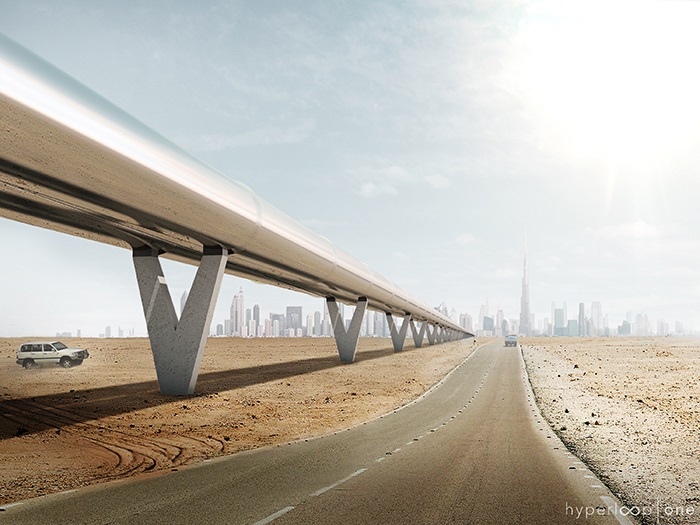Hyperloop
A hyperloop is a sealed vacuum tube through which ‘pods’ carrying people and/or freight can travel at speeds in excess of 650mph with almost no air resistance or drag. The concept is very similar to the system of vacuum tubes used by department stores to convey bank notes in small capsules at high speed from the tills to offices on the upper floors.
In theory, a journey by hyperloop from Los Angeles to Las Vegas (a distance of 270 miles) would take around 30 minutes assuming a speed of around 600mph. This compares to an estimated 2hrs 8 mins by high speed rail, 2hrs 42 mins by standard rail, 3hrs 28 mins by air and 4hrs 17 mins by car.
While some experimental hyperloops have been created over short lengths, there is still no real built example in use, although companies such as Tesla, SpaceX and Virgin Hyperloop are testing prototypes. Hyperloop therefore still remains a ‘proposed’ method for transporting goods and people. But perhaps not for long.
Since 2012, there has been a flurry of advances in hyperloop technology by various companies, although the credit for promoting the concept is often given to Elon Musk's Tesla firm which has offered it as open-source technology available to everyone. As a result, more companies have been formed to explore the concept.
North of Las Vegas, Virgin Hyperloop One has created a 500m long, 1.5m-radius tube in which pods have travelled at up to 240 mph. While Hyperloop Transportation Technologies has built a 1,000m test track in Abu Dhabi and is building a second in Toulouse, France.
[edit] Technology
The wheel-less, pressurised pods hurtling through a hyperloop are propelled by linear induction motors and axial compressors. With traditional wheels having been eradicated, the air bearings are designed to make the ride extremely smooth and quiet – analogous to travel by magnetic levitation (MAGLEV). A further benefit is that being in sealed tubes, the pods are not subject to disruption by weather events, people or animals on the track or level crossings.
However, travelling at such high speeds has its drawbacks: to avoid inducing nausea in passengers, the pods would take three minutes to accelerate to top speed, while negotiating a 90-degree bend would have to be performed over a distance of six miles.
[edit] Precedents
One of the first proponents of a train travelling in a vacuum was the US rocket scientist Robert Goddard who may have provided the inspiration for Elon Musk. Previous ideas for using a vacuum for propulsion have not met with great success. Brunel's atmospheric railway used a vacuum, but it comprised a wheeled train on tracks. Although it was initially successful in carrying passengers over a short distance, it ultimately failed because 19th century technology could not adequately maintain the vacuum in the tube. A lubricated leather strip was key to maintaining the seal but when it hardened and cracked, air would enter the system, thereby compromising the vacuum.
[edit] Related articles on Designing Buildings Wiki
- A detailed look at the ICE Enabling Better Infrastructure programme.
- ECA backs joint rail electrification statement.
- Electric vehicles.
- Highway authority.
- Infrastructure.
- Integrated transport system.
- Road traffic management.
- Smart motorway.
- Sustainable transport.
- Traffic engineering.
- Transport assessment.
- Transport design and health.
- Types of road and street.
Featured articles and news
RTPI leader to become new CIOB Chief Executive Officer
Dr Victoria Hills MRTPI, FICE to take over after Caroline Gumble’s departure.
Social and affordable housing, a long term plan for delivery
The “Delivering a Decade of Renewal for Social and Affordable Housing” strategy sets out future path.
A change to adoptive architecture
Effects of global weather warming on architectural detailing, material choice and human interaction.
The proposed publicly owned and backed subsidiary of Homes England, to facilitate new homes.
How big is the problem and what can we do to mitigate the effects?
Overheating guidance and tools for building designers
A number of cool guides to help with the heat.
The UK's Modern Industrial Strategy: A 10 year plan
Previous consultation criticism, current key elements and general support with some persisting reservations.
Building Safety Regulator reforms
New roles, new staff and a new fast track service pave the way for a single construction regulator.
Architectural Technologist CPDs and Communications
CIAT CPD… and how you can do it!
Cooling centres and cool spaces
Managing extreme heat in cities by directing the public to places for heat stress relief and water sources.
Winter gardens: A brief history and warm variations
Extending the season with glass in different forms and terms.
Restoring Great Yarmouth's Winter Gardens
Transforming one of the least sustainable constructions imaginable.
Construction Skills Mission Board launch sector drive
Newly formed government and industry collaboration set strategy for recruiting an additional 100,000 construction workers a year.
New Architects Code comes into effect in September 2025
ARB Architects Code of Conduct and Practice available with ongoing consultation regarding guidance.
Welsh Skills Body (Medr) launches ambitious plan
The new skills body brings together funding and regulation of tertiary education and research for the devolved nation.
Paul Gandy FCIOB announced as next CIOB President
Former Tilbury Douglas CEO takes helm.
UK Infrastructure: A 10 Year Strategy. In brief with reactions
With the National Infrastructure and Service Transformation Authority (NISTA).























